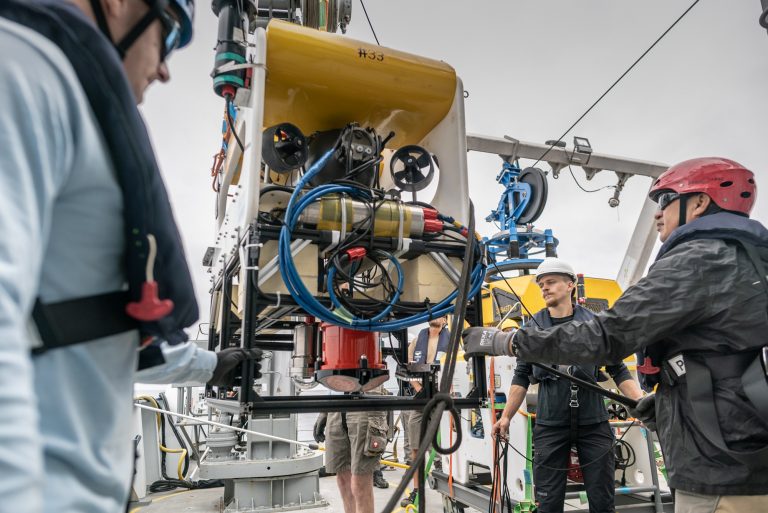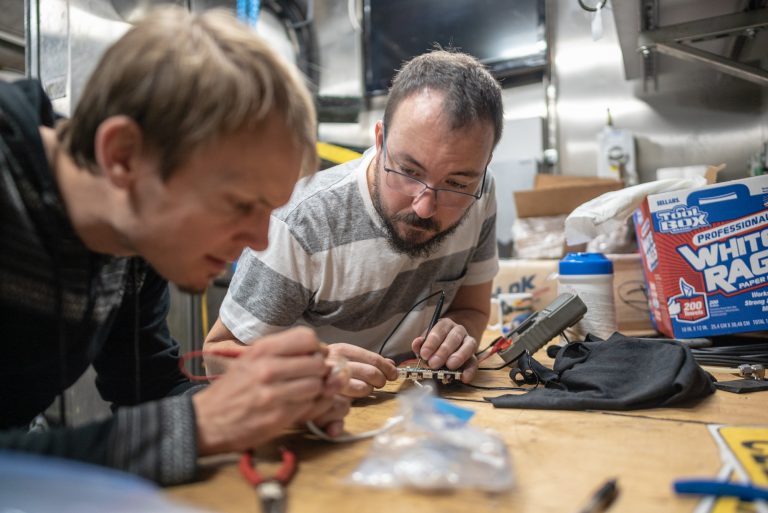All four robots involved in the Adaptive Robotics expedition have now gotten wet and proved that they are ready to carry out their main scientific missions on this cruise. This marks the end of Phase 01, meaning the team will now be able to concentrate in what really brought them to Barkley Canyon and Hydrate Ridge: using Artificial Intelligence to enable researchers to decipher the oceans at a much faster pace.
“Most people are familiar with the fact that there are robots in the ocean doing things,” says Dr. Blair Thornton, Chief Scientist. “But many people think that if we have the robots, then the challenge of studying the ocean is solved. However, the robot is only a platform to collect data, which humans need to interpret and understand in order to build new insight.” For Dr. Thornton it is very clear that there is a long way to go from collecting data to creating human understanding, and his quest is to narrow that gap dramatically.

Collected Potential
The expedition’s fastest robot stays ten meters off the seafloor, moving nearly five kilometers per hour – about the speed of brisk walk. The other robots operate much closer to the bottom, but are slower and can only cover one fiftieth of the area in the same period of time. Scanning the entire seafloor at this speed would simply take too long. There are technical and physical constraints to what technology can accomplish today. “Instead of waiting for the future technology to come our way, we need to push the technology we have,” says Dr. Thornton. “There’s a lot of data around the world that has been collected but has not been used, and I don’t believe that you can collect some data and say ‘I’ve done my part, now it’s up to the scientists to go and use it.’ You have to understand the motivations of the scientists and develop the methods that allow them to do their job efficiently – which is not scanning through hundreds of thousands of images, or days and days of video, or clicking and counting millions of features.” Dr. Thornton believes those are tasks better left for machines. The real focus of this mission is on making the best use of the data collected by the robots by rapidly allowing and generating understanding.

Nowadays, in just a couple of hours, autonomous robots collect information that might take months – or even years – to process and fully understand. By the time experts make a discovery, they are not likely to be onboard a research vessel. “It is only when you have that kind of understanding of the site that you realize that you could have done things differently, more efficiently, and better,” explains Dr. Thornton. “If we can understand what a robot just observed quickly, before our next deployment- instead of in six months time – we do not have to regret how we could have done things differently, we can make the absolute best use of time with what we have available.”
Add Context: Objective Data Processing
The team on board Falkor wants to make data processing faster while making the data itself better. Through precise algorithms, they expect Artificial Intelligence to move beyond simply presenting the scientists with a speedy summary of the information collected, also objectively interpreting the data in order to describe it in context, and even suggest what to explore next.
“At the moment where the technology is at, humans generally make the decisions. But if we can prove that interpretations made by the vehicles can be trustworthy, then we will be confident enough to hand over the responsibility without jeopardizing valuable opportunities to get important information.” Dr. Thornton’s team does not believe in complacency. If limitations exist, they believe the answer is to push technology further. Phase 01 is over, and now it is time to discover where the Artificial Intelligence can lead us.


